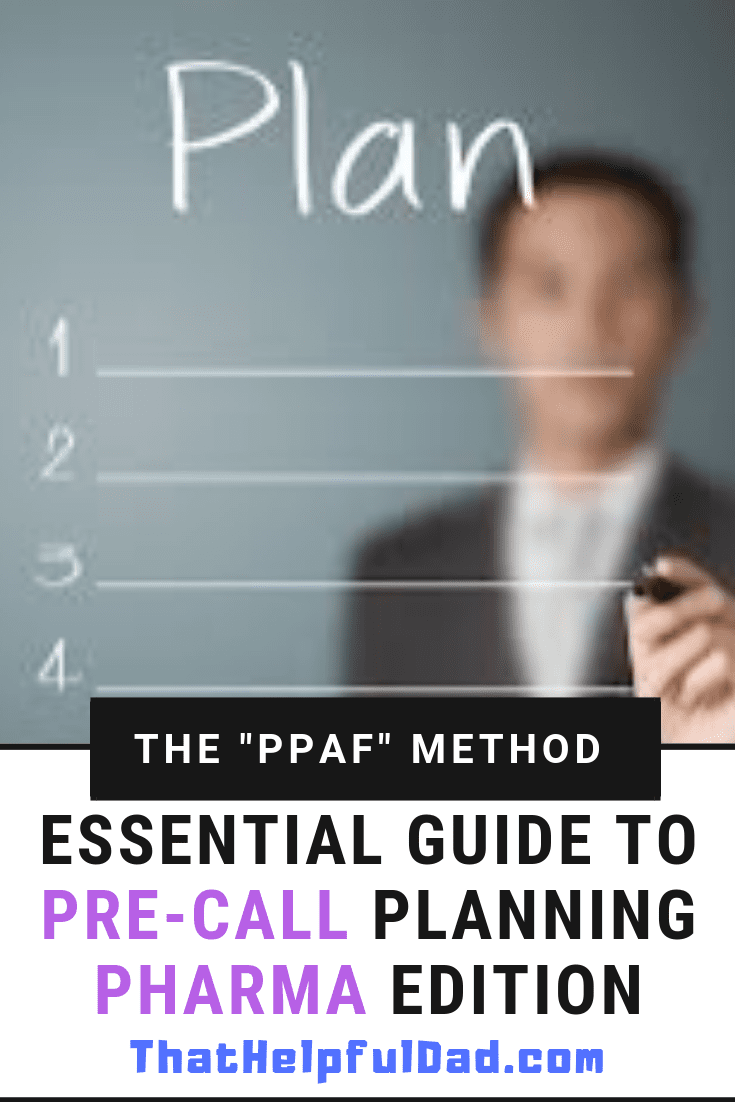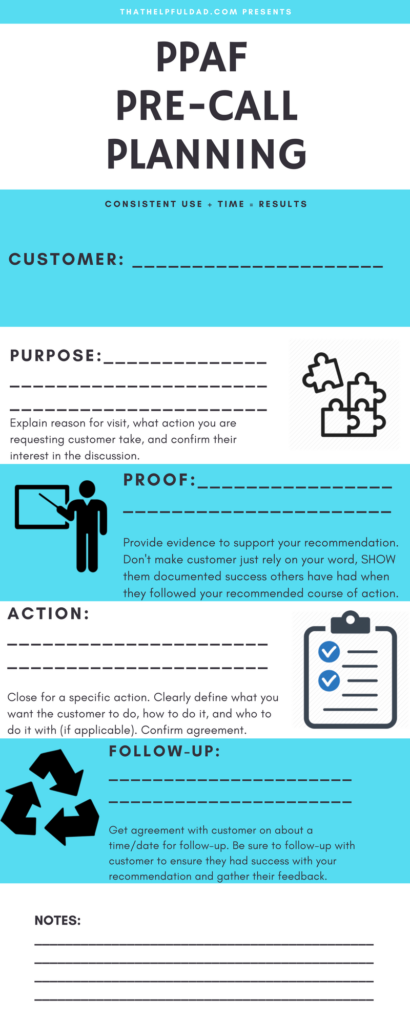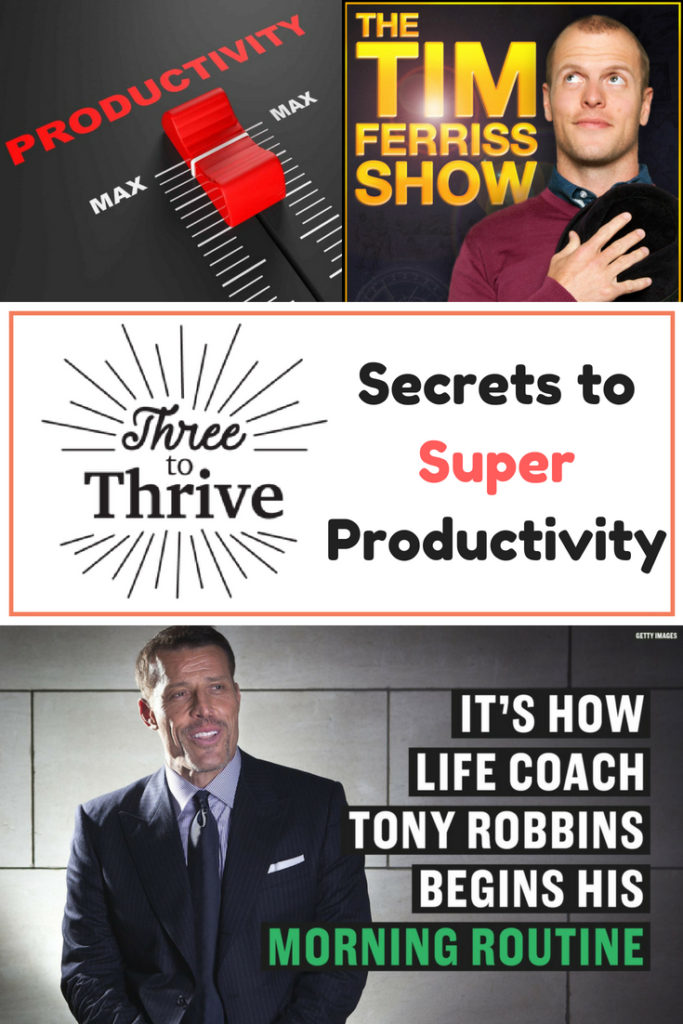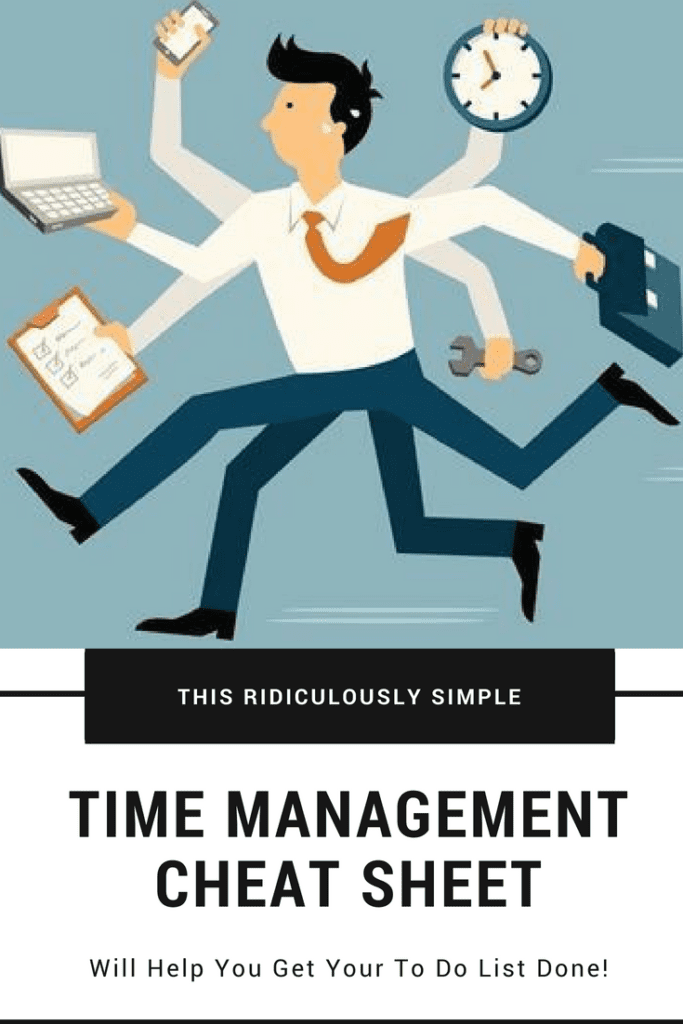Are you involved in sales – either as a sales agent, rep, trainer, or manager? If so, this article can help you and your team — I’ll explain the importance of pre-call planning as relates to sales in general, talk about the method I use called PPAF Pre-Call Planning, share my tips on how to use the PPAF method to do pre-call planning quickly and effectively, and also give you access to a free printable so you can use the PPAF method yourself.
Pre-Call Planning Table of Contents
- Why listen to me?
- What is Pre-Call Planning?
- Benefits of Pre-Call Planning
- Pre-Call Planning Best Practices – The Video
- The PPAF Method of Pre-Call Planning
- PPAF – The Purpose
- PPAF – The Proof
- PPAF – The Action
- PPAF – The Close
- PPAF – Notes
- PPAF – Download the Handout
- Links to Learn More
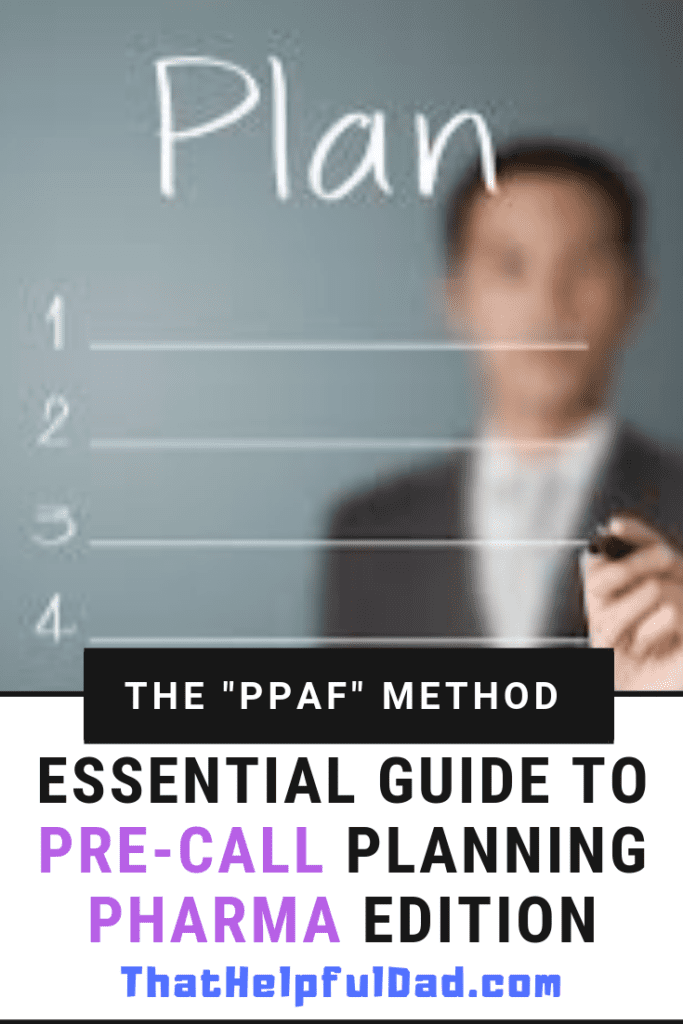
Editor’s Notes:
- You can access these tips in written form in this article or watch it via video below.
- In this article, I’ll talk about pre-call planning in the pharmaceutical sales industry, but this strategy is adaptable to almost any customer-facing sales interaction that has a long-term sales cycle.
- I don’t know everything and would welcome your feedback. I invite YOU to share your tips and feedback about pre-call planning too – I’m always looking for new ideas to improve.
I. Why Listen to Me?
First off let me say that I don’t tout myself as a sales-guru and I haven’t written any best-selling books about sales (at least not yet), instead I prefer the path of humility. All that being said, I do live and breathe sales in the real-world every day and have done so for the last 25 years as a front-line (AKA customer-interacting) salesperson. I’m not taking credit for inventing ‘pre-call’ planning, nor am I saying the PPAF method is best. I’m just here to share with you some strategies that I’ve learned during my long sales career that have made a measurable difference for me.
I use the PPAF method every day. It works. And I consider the PPAF method one of the ‘pillars’ of my sales success.

I’ve worked in a number of industries during my career (financial services, pharmaceutical sales, retail, medical device sales, etc) and regardless of the industry I’ve been blessed to consistently beat my sales quotas year after year after year — I’m currently on a 8-year run of 100%+ quota achievement with revenue and sales volume growth each year and I can tell you that the PPAF method is a big part of that success.
Did you know?
Pretty much every sales rep I’ve ever trained or manager I’ve worked with over the years has complimented me on the use of the PPAF method as a best practice and many of them have adopted it for themselves and their teams.
I’m sharing it with the PPAF method with you today because I like to give people practical solutions that help them succeed. If you enjoy this tip, be sure to check out the rest of my website for more helpful wisdom like this.
II. What is “Pre-Call” Planning?
The concept of ‘pre-call planning’ is not new and there are a number of excellent articles that discuss pre-call planning in addition to my thoughts on the topic – I’ll list some in the references below.
For the purposes of our discussion, we’ll define pre-call planning as follows…
If the ‘call’ itself is the customer interaction, then the ‘pre-call’ is the PREPARATION BEFORE that interaction.

III. Benefits of Pre-Call Planning
Why spend time in ‘pre-call’ planning?
Because there are numerous benefits to consistently conducting a pre-call plan.
I like to think of the pre-call plan as an ‘investment’ that has a high ROI.
Consider the following benefits you will experience as a result of pre-call planning…
- Time is precious – we live in a fast-paced world where nobody seems to have time anymore. Pre-call planning allows you to make better use of the limited time you have with your customers. It also shows them that you respect their time and yours – by coming in with a plan your professionalism will be self-evident and this will immediately add to your credibility.
- Focus on your goals – surely you have a goal of what you’d like to accomplish during your customer call, right? The Pre-call plan will help you keep that goal in sight – not just for yourself, but for your customer too. That focus will give you a better chance to achieve the goal.
- Proper Preparation Leads to Better Results – it may be a cliche, but it’s true. Pre-call planning need not make you a robot incapable of being flexible during the call if need be, but it will make you better prepared. You’ll have your proof sources ready to help the customer be more confident in the action you are recommending, you’ll anticipate customer objections and be ready to work through them, you’ll know where you want to take the call, etc. All that preparation, combined with your focus on a specific goal, will increase your goal achievement.
- Consistency of Method: if you find a strategy that works, you want to repeat it, right? That’s the point of pre-call planning – it’s a proven strategy that works and if you use it consistently over time, your results will improve too.
- Bring Value – There’s a saying in the pharmaceutical industry “Be Brief, Be Brilliant, and Be Gone” – your customers don’t have time to spend all day with you, they are busy, but if they agree to meet with you then their doing so with the expectation that you will provide them something of value they can use to make their jobs easier. Using a pre-call plan allows you to provide that value to them in a streamlined manner and earns you their respect in the long run. This will result in the customer wanting to see you because they’ll have confidence you can help them.
- More Sales – the bottom line in sales is more sales, right? Pre-call planning gives you the roadmap to make every customer interaction have a higher chance of resulting in a sales because the prize is always in sight AND both you and the customer know the purpose of the call. The result is a higher close rate.
IV. Pre-Call Planning Best Practices – The Video
Now that we know WHY we want to pre-call plan, let’s talk about the HOW. If you are a visual learner, check out this video on Pre-Call Planning, otherwise, keep reading to see the text version of the PPAF Method.
V. The PPAF Method of Pre-Call Planning
I mentioned above that I believe in practical solutions. During my long sales career, I’ve been exposed to tons of various pre-call planning methods. In the case of pre-call planning, there are a lot of ways to skin the cat. The PPAF Method is simply my boiled-down-to-the-basics, practical solution version of pre-call planning.
The PPAF Method is not rocket science and when you read it you’ll probably say “duh, that’s obvious.” While that may be true, the fact is that that 90% of salespeople I’ve met during my tenure do not do any pre-call planning, and/or don’t have a consistent method they follow, and/or don’t use a method focused on a specific sales goal. As a result, 90% of salespeople struggle to make their sales quotas consistently. This lack of consistency has long been lamented to me by countless managers of said reps who’ve repeatedly asked me to share the PPAF method as a best-practice.
Without further ado then, here is the PPAF Method of Pre-Call Planning…
Purpose, Proof, Action, Follow-up.
Ah, that’s it?
Yup, pretty much.
As I said, PPAF is simple. It’s easy to use. And it works.
Here’s a visual cue-card I use daily to plan for each call – you can print this or scroll down to download a free copy for yourself.
Now that we know what PPAF is, let’s unpack this a bit more to really understand the components so you can be the most effective with this method.
If you haven’t already, I recommend you watch the video above so you can see me discuss this live and get all my tips. Don’t worry. I’ll wait…
VI. PPAF – the Purpose
PURPOSE – this is your reason for the visit.
I recommend you state it upfront as one of the first things you say to the customer after you exchange pleasantries, etc.
For example, “Hey Doc, the reason I’m here today is to discuss how you can use Product X to help Patient Y with Condition Z, is this something you’re interested in discussing?”

Why take time explaining your purpose?
The Purpose is a critical step because not only does it cut to the chase immediately but it helps both you AND the customer focus on a clear goal for this interaction.
In this case, we’re asking the doctor to use Product X for a specific patient profile (i.e. one with condition Z). This focus lets everybody know the ‘roadmap’ for the call that is occurring.

Mike’s Pro Tip:
To take this to the next level, I like to gain agreement on the purpose PRIOR to the actual visit – I do this during the ‘follow-up’ stage of the previous call and/or by sending an email to the customer that defines the purpose of my upcoming visit prior to the meeting. This allows you to say something like “as we agreed on the last call…” or “like I said in my email…”
Note the question about ‘Are you interested in…?’
This is another critical part. Not only does it get you into the closing mindset but it also gets the customer into the ‘yes’ mindset — assuming they say ‘yes’ to your initial proposal.
But what if they say ‘NO’ to your purpose?
Great question.
Over the years I’ve found that many sales reps are so afraid of getting a ‘no’ that they fear to ask even the most basic question such as this one.
However you NEED to know the answer to this question before you can move forward.
If the customer says they are not interested in your discussion, then this is a signal you have more work to do before you can proceed down the sales path related to this goal (i.e. getting the doctor to prescribe Product X for this patient profile).
If you don’t get buy-in on the purpose of your visit and instead proceed forward with the sales call, you’ll never know that your customer isn’t ready to ‘buy’ your recommendation.
As a result, you’ll waste their time and yours AND worse yet, you’ll be putting a dent in your credibility with this customer. All that can be avoided by asking the ‘are you interested’ question.
Now assuming they do say ‘yes,’ and assuming your proposal is reasonable and backed by credible evidence, then asking the ‘are you interested’ question is a form of trial closing that helps the customer put themselves in the buying mindset.
Why does this matter?
If you gain agreement on your Purpose, then when you get to the Action close later, your customer will be more inclined to agree with your recommendation.
It’s pure gold and it works.
VII. PPAF – The Proof
PROOF – this is the ‘evidence’ you have to support your recommendation.
In our pharmaceutical example, it could be a clinical reprint that shows the efficacy of using Product X for a patient with condition Z, or maybe it’s your detail piece or another visual aid on your mobile device.

Whatever the documentation is, it must be relevant and compelling.
Most importantly you have to be prepared to present the evidence succinctly and clearly show WHY/HOW it’s relevant – remember that “Be Brief, Be Brilliant, Be Gone” part above – this is where the rubber meets the road for that mindset.
For example, “Did you see the article by Bob Evans in the March issue of the New England Journal of Medicine? Dr. Evans conducted a trial about patients with Condition Z and he found that patients who used Product X were able to reduce Condition Z by 35%. What’s your opinion on this research?”
Obviously, it goes without saying that this is a watered-down example. In the pharmaceutical world there are additional best practices for presenting clinicals (I prefer the SOAP method) and it’s important to present an unbiased review of the paper which includes a discussion on safety as well. But hopefully you get the idea…
In the example, the Proof I’m using is clearly related to the Purpose, I’m verbalizing that and confirming the customer agrees, and I’m setting up my Action close to follow — that’s the key takeaway here.
Note: in the example, “Bob Evans” is a respected ‘Key Opinion Leader” in the same field of practice as our customer – that’s important because if we know our customer thinks highly of Dr. Evans as a thought leader, then we are able to effectively use our Proof to validate the action we’re about to recommend to our customer. It becomes a case of “Don’t take my word for it, remember, this is what Dr. Evans does for his patients too…”
The Proof Step is probably the part that most sales reps struggle with and I did early on in my sales career too.
With lots of responsibilities it’s tempting to not put in the time to really know your proof sources – unfortunately, that leads to problems when you want to use them with customers because you end up struggling through this critical step in the PPAF process (or worse yet you try to skip this step altogether). Please don’t do that.
When you fail to provide Proof and/or you are unable to explain it confidently (and concisely) you’ll lose credibility with your customer – and you will both FEEL it.
I know. I’ve been there. It’s no fun. It’s a sales killer.
Instead, do the preparation you need to know your proof source — it’s an investment that will pay off 10-fold.
Your Objection: But I’m not a doctor/expert?
I hear you. I get it. I’m not a doctor or expert either. But I still provide Proof and you should too.
I’m not saying you have to be an expert in every aspect of the customer’s business (for example, if you are a pharmaceutical rep presenting to doctors, nobody expects you to be the doctor and no every disease he treats), but it is reasonable for you to be an expert about your product and it is reasonable for you to be confident with your proof source such that you can answer questions about it (or know where/how to get answers if they are beyond your expertise).

Mike’s Pro Tip:
The Proof step should involve a DIALOGUE, not just a monologue from you. During the Proof presentation, it’s important to use check-in questions to ensure your customer is following along and understanding the proof.
Examples include “What do you think about how this research was set up?” or “Are the patients in this trial similar to yours? Why/Why not?” or “What are you doing similar/different to Dr. Evans?” or “What kind of results are you getting when you use Product X with Patients who have Condition Z?”
The Q&A during the Proof Step is critical because it will uncover any hidden objections you need to work through prior to presenting your recommendation.
Now YOU teach me – how do YOU handle the ‘Proof’ stage? Drop a comment below so I can learn from you too.
VIII. PPAF – The Action
ACTION – this is your close.
Your close is the action you want the customer to take and the more specific you can be about it, the easier it will be for your customer to understand, the more reasonable you will appear, and the greater chance you will have to gain agreement on your recommended action.

A word about specificity – keep in mind we’re not asking for the moon here…
We’re NOT asking our customer to use Product X willy-nilly for ALL his patients with every condition under the sun.
That doesn’t work and it will ruin your long-term credibility.
Instead, we’re simply asking for him to use Product X for patients who have Condition Z and this recommendation is back by research from a key opinion leader whom our customer respects and who uses Product X in the exact same manner we are proposing.
It’s not rocket science.
It’s a reasonable action that’s proven to work (just like the PPAF method!)
Are you ready to close for action?
Here’s where we are in our sales call…
- By now you will have had a healthy dialogue;
- You’ll have presented proof that backs up the action you’re about to recommend;
- You’ll have worked through any objections your customer might have had;
- And to be honest, the action close is essentially a foregone conclusion because you AND the customer have been focused on this goal the entire call. It’s now time to close the deal.
Continuing our example, here’s what it looks like…
“So Doc, you’ve seen how Dr. Evans is using Product X to treat his patients with Condition Z and you said you’d love to get similar results for your patients too. If that’s true, then is it reasonable to ask you to use Product X with your patients who have Condition Z?”
This this is a really watered down version and I’d customize it more but for the purposes of our discussion, it gets the point across…
The Action tracks back to the Proof which tracks back to the Purpose.
It all flows in a straight line. It makes sense. And it makes it EASY for the customer to say “Yes.”
Additional customizations include:
- “Do you have any patients who have condition Z now? Can we try Product X on them and monitor the results?”
- “When’s the next time you expect to see a patient with Condition Z? Would you be willing to try Product X to help them?”
- “Let’s do this – how about the next time you get a patient with Condition Z, you try Product X? Then on my next visit, we can discuss your results and see if you’re getting the same great outcomes as Dr. Evans.”

Mike’s Pro Tip:
Try this ‘Next Level’ Version of the Action Close…”Hey, Doc, what do you think about this? How about you trial Product X on your next few patients with Condition Z and we’ll monitor the results. Meanwhile, I also reach out to Dr. Evans and see if he has any availability to meet live with us – I can then work with your group admin to set up an interactive forum discussion on the topic using one of my company’s on-label case study presentations. Would that be of value to you and your team?”
Why is this next level?
Because this type of action close allows you to continue the ‘key opinion leader’ sales tactic and provides further encouragement and support for your customer to proceed down the path you are recommending – it’s a great value-add proposal).
Follow that up with this verbiage tidbit too…
“Rest assured, Doc, I’m here to set you up for success so if you have any questions about the use of Product X, both myself and my medical team are available to help you so you’re never alone in the process.”
Now YOU Teach me – what closing best practices do YOU use?
I’m always looking to add to my repertoire so please share!
Don’t forget – as with the Proof step, the pharmaceutical industry has additional requirements to that may be required to include. Your industry may be the same. Modify the discussion as necessary to fit your needs.
IX. PPAF – The Follow-Up
FOLLOW-UP – This is how you set up your NEXT call with the customer and follow-up with the support staff.
Any salesperson who’s had long-term success will tell you that consistent follow-up with customers is one of the basic pillars of their success. Lots of people can close a sale…and never see that customer again. It’s the ones who follow-up with their customers who get that customer to buy more AND get that customer to tell other customers about you too (which results in more sales).

In our example we would set up our follow-up for our next call during the current call with something like this…
“Ok, Doc, so you said you’d give Product X a trial with your next few patients who have Condition Z and you said you think you’ll have 3-5 patients you can try this approach within the next couple weeks, right? So how about I stop by in two weeks and we see how it’s going? What’s a good time for our next meeting? Would the 14th at 7 am before you see your first patient of the day work? If not, how about the 16th at 4 pm after you finish your hospital rounds?”
Be sure you actually do the follow-up!
You’ve invested all this time and effort to produce the sale. The customer has bought into your proposal. The sale is closed. Life is good.
It’s easy to drop the ball here and focus on getting more sales from other customers, but that would be a mistake.
You’ve got a great customer here. Follow-up with them. Ensure they have success. Ensure they are a repeat buyer. Then get them to tell their friends too – that’s a much easier path to more sales than always trying to develop new customers from scratch.

Mike’s Pro Tip:
If you build a great relationship with this customer and they become an expert user with your product, a whole new world of new options open up…
- Perhaps this customer will become a local key opinion leader for you?
- Maybe they will be interested in doing research that will help the product’s market grow?
- Maybe they’ll become a personal friend to enrich your life?
That’s the power of effective follow-up and I can tell you it works because I’ve done all of these things with follow-up and more. Try it!
Now YOU teach me – what are YOUR favorite ways to follow-up? I’d love to know your ideas on this important step.
X. PPAF – Notes
Additional Tips:
Use a Notepad – during my sales calls, I always carry a notepad. I use it for two reasons…
-
- First, because I write out my entire PPAF on the notepad and use that notepad with me during the customer interaction — this ensures I have my roadmap always in front of me and helps keep me on the path towards my goal.
- Two, because I take notes during the call to capture key items for follow-up.
- If it’s the first time I’m working with a customer I will ask “Do you mind if I take notes?” In 25+ years I have never had a customer say ‘no.’
- I believe taking notes adds an aura of professionalism to the process – it shows the customer I care about what they have to say and I think it gives them confidence that I will actually do what I say I will do because I’m writing it down to remember it.
Why the name PPAF?
-
- Obviously, the first letters of each word (Purpose, Proof, Action, Follow-up) spell the acronym “PPAF.”
- I could have changed it to something else and added more steps to make a better word, but honestly, that would just be marketing fluff.
- PPAF is a unique and admittedly stupid word, but it’s so off the wall that it makes it memorable – at least for me. I’m hoping you will feel the same.
- PPAF – it’s simple. It’s catchy. It’s easy to remember. Give it a shot.
XI. PPAF – Download the Handout.
Click here to download a pdf version of the PPAF method that you can use in your own sales calls…
XII. Links to Learn More…
- http://blog.customercentric.com/blog/sales-tips-10-reasons-for-pre-call-planning
- https://www.themhedajournal.org/2002/04/15/pre-call-planning/
- http://salesmomentum.com/app/section-6/
- https://toplineleadership.com/4-coaching-questions-for-pre-call-planning/
More Video Tips
https://youtu.be/p870MaBPWo0https://youtu.be/n1tX5-dTMN8
Don’t Miss These Helpful Tips too…
Boost your productivity with these tips too…

